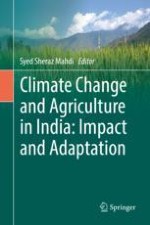2019 | OriginalPaper | Buchkapitel
20. Impact of Climate Change on Temperate Fruit Production in Kashmir Valley, North Western Himalayan Region of India – Challenges, Opportunities and Way Forward
verfasst von : Nazeer Ahmed, F. A. Lone, K. Hussain, Raihana H. Kanth, S. Sheraz Mahdi
Erschienen in: Climate Change and Agriculture in India: Impact and Adaptation
Aktivieren Sie unsere intelligente Suche, um passende Fachinhalte oder Patente zu finden.
Wählen Sie Textabschnitte aus um mit Künstlicher Intelligenz passenden Patente zu finden. powered by
Markieren Sie Textabschnitte, um KI-gestützt weitere passende Inhalte zu finden. powered by
